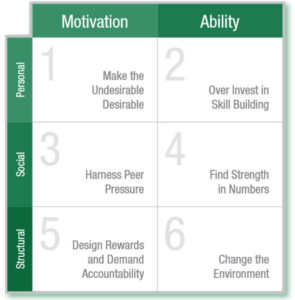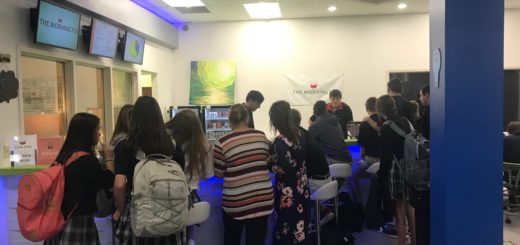Influencer Book Review
One of the books I am reading to help with organizational change and specifically our Entrepreneur Track initiative is Influencer: The New Science of Leading Change by Joseph Grenny. This book, like many others on my reading list, are intended for the business world rather than the education world. This brings up an interesting conversation that Dean Shareski brought up in a recent post, The Unique Leadership Challenge in Education. He brings up the notion that educational leadership differs from the business world in multiple ways. However he notes, “as educators, I think it’s important for us to look outside ourselves and our institutions for lessons and ideas on how to make learning and our schools better” (Shareski, n.d.). I agree we can take ideas from outside the education world and here is what I have taken from Grenny’s Influencer.
First Grenny talks about how measurement is an integral part of a change effort. He says it not only informs but drives overall behavior. So we first need to identify what results we want to achieve.
Desired Results of our Entrepreneurial Track
- Have a student designed and promoted business up in running in two and a half years
Then as influencers we need to be vigilant in identifying what he refers to as “vital behaviors.”
Vital Behaviors of our Entrepreneurial Track
- Teaching that relies on inquiry, not simply direct instruction and emphasizes improvement not perfection through reflection.
- Find and engage many different entrepreneurs who will be willing to lend their expertise as mentors to students and instructors in the class.
- Use ePortfolio to reflect upon the learning as students and instructors as well as promote the business.
Grenny discusses noticing the obvious behaviors that will lead to success and identify what busters will put your success at risk. He notes that finding positive deviants, those who live in the same system but produce much better results, will help you discover what traits you need for success as well. I think this is a very interesting part of our initiative as we are looking to engage entrepreneurs who are by definition positive deviants. We also need to look for teachers who are bought into a socratic way of teaching that emphasizes inquiry and reflection.
Organizational Influencers for the Entrepreneurial Track
We also need to identify who are the most important influencers on our initiative. Obviously the first will be the everyday teachers. They will have the majority of the responsibility of inspiring the students to success. They will also have responsibility for interacting with the mentors. However, if we do not identify the proper entrepreneurs to mentor this project it will have no hope of success. We hope to find a variety of entrepreneurs to engage in our success. Since we do not know what type of business the students will select, we must identify as many different entrepreneurs as possible. These two groups will have the largest influence on our success and must be selected wisely.
Knowing all of this has made me think deeply about who do we need to engage in our initiative to achieve success. We know that identifying the core teachers who will lead the program is going to be vital. Possibly even more vital to the success however, is finding entrepreneurs to bring in the expertise we as teachers don’t have in designing, promoting and running a business. This brings us to the crux of the book which is the six unique sources of influence.

(Crucial Conversations and Influencer – SlideShare, 2011)
Let’s look at these one by one in the context of our Entrepreneurial Track and the vital behaviors that will lead to successfully launching a business.
Personal Motivation – What motivates our instructors, teachers and mentors, to ask questions and encourage reflection? As we are identifying instructors and mentors, we need to ask them why they are interested in helping with the program. I want to make sure we have instructors in this class that pose problems and then help guide students to solutions instead of simply lecture. As we bring in outside entrepreneurs to teach portions of the class it is going to be important to make sure they understand this as well as the everyday instructors. We also want the instructors to buy into the reflection/portfolio piece.
- Identify entrepreneurs and teachers who are on board with the inquiry model
- Require reflection prompt for each week of instruction
Personal Ability – I feel strongly that we need to identify real entrepreneurs in our parent and friend community to bring this ability to the forefront. That is why we want to form a committee of those people to come in and help backward design the class (find out what skills are most important for students to learn in order to develop a business plan and run a business). Then ask those and other entrepreneurs to serve as instructors and then mentors for the actual business.
- Form a committee of entrepreneurs and teachers to backwards design course so topics needed to start business are identified
- Find mentors to serve as leaders for each topic based on expertise
- Review lesson plans with instructors/mentors to ensure inquiry and reflection
Social Motivation – I think the everyday instructors should be reflecting their learning through an e-portfolio to model. I also think the way we handle the creation of the class should model the way we want the class to be. Be bringing together a committee and asking questions to backwards design the class I think we accomplish this. I also believe sharing research that supports the need for inquiry based teaching, reflection and entrepreneurial skills will reinforce the motivation for the class. Finally I think showing examples of other high school aged entrepreneurs will serve to demonstrate this is possible.
- Have instructors model reflection
- Share research amongst instructors and mentors
- Examples of successful businesses run by high school aged entrepreneurs
Social Ability – I think as we look as entrepreneurs we need to make sure we cast a wide net. We have identified a fashion blogger and website designer who are entrepreneurs that would help in modeling the behaviors we want. This is in addition to more traditional entrepreneurs such as a home builder, retail businesses, photographer as well as a non-profit startup. We need to also carve out synchronous and asynchronous time for our group to interact. We will need to provide opportunities for students to go to some of the mentors businesses to see things in action.
- Create synchronous meeting times for committee of entrepreneurs and teachers to backwards design course
- Create synchronous and asynchronous times for instructors and mentors to prepare for class
- Create ePortfolios for instructors and ultimately students
- Create opportunities for students to visits mentor’s businesses
Structural Motivation – I think the everyday instructors and mentors will be receiving immediate feedback to their effectiveness through the success or failure of the students projects initially. Then during pre-launch and launch they will see the fruit of the labor in the actual business as well as the excitement of the students in creating something tangible.
- The project-based learning of the initial class will allow for mentors and instructors to see improvement and critical thinking
- The ePortfolios will serve as a window into the students’ learning
- Having students send thank you notes and letters after each entrepreneur teaches their section
- The creation of the business will show direct evidence of mentors’ impacts
Structural Ability – By allowing the entrepreneurs to help design the class they can choose the parts they are most drawn to. Then they can feel comfortable teaching or mentoring in that area. The everyday instructors will be chosen based on interest in this type of learning. Classrooms will be flexible in multiple ways. We will utilize the seating and layout of our new classrooms to encourage collaboration and critical thinking (read more about our classroom redesigns here). Once we get into pre-launch and launch phases we will be taking multiple field trips to gain the knowledge needed to run our business.
- Mentors and instructors will work with the part of the business they are most drawn to
- Classroom designs that encourage collaboration and critical thinking will be utilized
- Field Trips to businesses will be utilized to gain specific knowledge necessary
Grenny talks about how we need to utilize as many if not all of the six sources of influence to be successful in creating change. As I have read the book and looked at our initiative I can see how important these will become. Since we desire to have a business designed and created in two and a half years all these things must fall into place. Even more importantly the fact that the students will themselves determine the business, it’s design, promotion and funding we cannot lay out a plan for them. Making sure we always maintain the focus on our vital behaviors and six sources of influence will ultimate lead to attaining our goal.
While all of the points raised in Influencer may not align to educational leadership, I know after reading the book we cannot discount their importance. I look forward to reviewing The 4 Disciplines of Execution: Achieving Your Wildly Important Goals in my next blog post.
Resources
Crucial Conversations and Influencer – SlideShare. (2011, June 14). Retrieved October 23, 2016, from http://www.slideshare.net/Leadership_Consulting/crucial-conversations-and-influencer
Grenny, J., Patterson, K., Maxfield, D., McMillan, R., & Switzler, A. (2013). Influencer: The new science of leading change: 2nd ed. New York: McGraw-Hill Education.
Shareski, D. (n.d.). The Unique Leadership Challenges in Education. Retrieved October 23, 2016, from http://ideasandthoughts.org/2016/10/22/the-unique-leadership-challenges-of-education/


